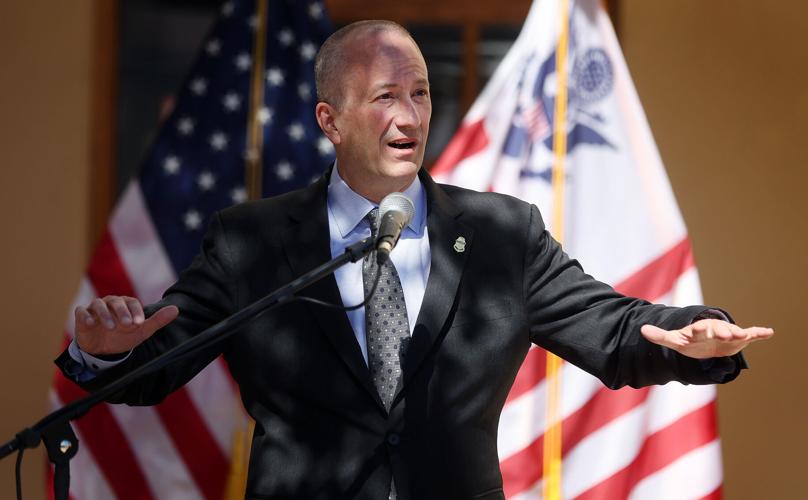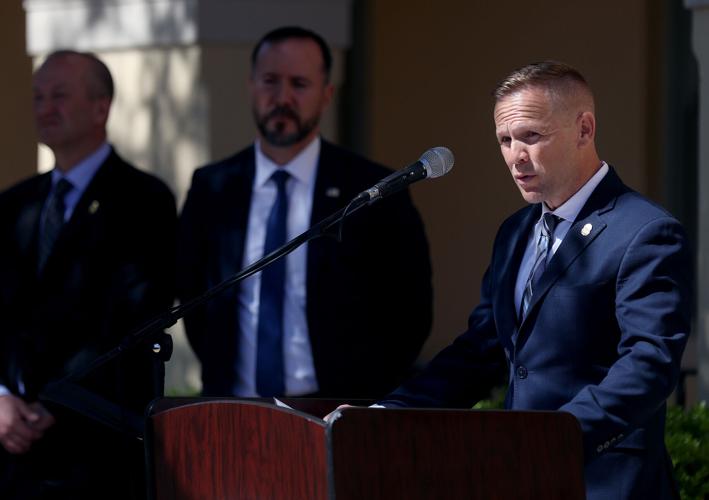NOGALES — By targeting criminal leaders in Sonora, disrupting fentanyl-manufacturing supply chains and stopping U.S. weapons from reaching criminal groups in Mexico, federal law enforcement officials said Wednesday they aim to stem the flow of fentanyl into the U.S. and bring criminals to justice through an expanded inter-agency collaboration.
Calling the operation “the next phase in our fight against fentanyl,” U.S. Customs and Border Protection Commissioner Troy A. Miller said CBP and its partners will target “plaza bosses” — criminal leaders who control a particular territory — starting with the plaza south of Nogales, Sonora, controlled by the Sinaloa Cartel.
“We know more than 90% of all narcotics smuggled into U.S. … are under the control of border plaza leadership,” Miller told media gathered at the historic U.S. Custom House, next to the DeConcini Port of Entry. “This campaign will have a tremendous impact on the cartels’ ability to smuggle this dangerous drug across our borders.”
One of the Sinaloa Cartel’s top lieutenants, Sergio Valenzuela Valenzuela, also known as “Gigio,” is plaza boss in Nogales, Sonora, the territory responsible for 44% of the fentanyl being trafficked to the U.S., making it the top fentanyl-trafficker of all 27 plazas operating in Mexico, Miller said.
By naming plaza bosses, CBP hopes to increase public and law-enforcement pressure on them. Valenzuela has been indicted on drug-related conspiracy charges and a 2018 warrant for his arrest was unsealed in 2021. Valenzuela was designated as a narcotics trafficker under the Foreign Narcotics Kingpin Designation Act and is still at large, Miller said.
The operation will also intensify efforts to stop attempts to smuggle U.S. weapons into Mexico, “severely hampering (cartels’) ability to arm their operations and drive chaos on the other side of our shared border,” Miller said.
The Department of Justice found 70% of firearms recovered in Mexico between 2014 and 2018 and submitted for tracing were sourced to the U.S., and Mexican officials have said the percentage is even higher.
“U.S. firearms trafficked into Mexico, along with the U.S.’s high demand for illegal drugs, contribute to security and drug crises on both sides of the border,” according to the conclusion of a September 2023 Government Accountability Office audit of U.S. security assistance to Mexico.
Last month a federal judge affirmed the Mexican government can sue five Arizona gun dealers over claims they contribute to violence in Mexico.
CBP’s new operation, dubbed “Operation Plaza Spike,” is a collaboration with the U.S. Drug Enforcement Agency and Homeland Security Investigations, as well as local and state partners, and the Mexican government, officials said. Information sharing between those partners will be a key component to tackling the trans-national operations driving the illicit fentanyl trade.
“We are laser-focused on defeating the Sinaloa and Jalisco cartels, the two organizations causing the worst drug crisis in our nation’s history,” said James Nunnallee, deputy chief of operations at the DEA.
The DEA has created three counter-threat teams: one dedicated to each cartel, and the third “to target the global illicit finance networks employed by both cartels,” Nunnallee said.
He said they’re tackling multiple aspects of the supply chain, including Chinese chemical companies responsible for supplying the ingredients used to make fentanyl. Last year, for the first time, the DEA and Department of Justice charged 12 Chinese chemical companies and 24 Chinese nationals with trafficking fentanyl, Nunnallee said.
Non-intrusive inspection equipment at ports of entry, where CBP seizes the vast majority of the fentanyl coming into the U.S., will continue to be critical in the fight against fentanyl, officials said. Last year CBP seized more than 27,000 pounds of fentanyl — about 1 billion pills — which was nearly twice the amount the year before, Miller said.
Most of the detained fentanyl smugglers are U.S. citizens or legal permanent residents, said Nogales Port Director Michael Humphries after the news conference.
Migrant-rights advocates say undocumented border-crossers who can’t afford to pay smugglers are sometimes forced to bring drugs into the U.S. by criminal groups who now control human-smuggling routes in northern Mexico.
Non-intrusive inspection equipment is key to locating illicit substances, currency or weapons, without disrupting the flow of traffic and commerce at the nation’s busy ports of entry, port officials say.
NBC News reported in March that some U.S. ports of entry have uninstalled fentanyl-scanning equipment sitting in warehouses, due to the lack of funding by Congress.
But at Nogales’ two ports of entry, all non-intrusive inspection equipment has been funded and installed, Humphries said.
In February and March, CBP officers seized 13 AK-style weapons, four pistols and more than $50,000 in cash “destined to Mexico to support Transnational Criminal Organizations,” Humphries said in an April 5 post on X, formerly Twitter.
Miller said CBP has non-intrusive technology at all ports of entry, but its use needs to be expanded, and Congress recently allocated funding to do just that. Miller told NBC News in March that less than 5% of personal vehicles entering the U.S. are scanned, and 20% of commercial vehicles. He’d like to raise those figures to 40% and 70%, respectively.
The “Plaza Spike” operation is the latest in a line of CBP operations with names like “Blue Lotus,” “Four Horsemen” and “Artemis.”
These inter-agency collaborations focusing on fentanyl interdiction have paid off, Miller said. Last year, CBP surged resources to the Southwest border, particularly in the San Diego sector, resulting in a near-doubling of fentanyl seizures, he said.
The agency has also improved information-sharing between agencies, through its “Operation Apollo” that began in October, and has spent years mapping out Mexico’s “plazas” and their leaders, to understand how to best disrupt their activities, Miller said.
But tackling the fentanyl problem will also require efforts throughout the U.S., to help those struggling with addiction and to spread awareness about the dangers of fentanyl, officials said.
“It’s going to take, beyond the border, (addressing) the demand. It’s going to take counseling, the medical community. It’s a huge problem in the U.S.,” Humphries said.
The White House has announced new steps to crack down on illegal drug trafficking, specifically fentanyl.The announcement comes as fentanyl seizures along the southern border continue to rise. Last year, more than 15,000 pounds of the synthetic drug were seized at the border. The Biden administration hopes to cripple the dangerous drug's supply chain through a series of new actions. "We're going after the criminal facilitators and enablers and the targeting of key vulnerabilities in the illicit fentanyl supply chain to maximize our impact across the drug producer and trafficker spectrum of capabilities," Dr. Rahul Gupta, Director of National Drug Control Policy told, Scripps News. They are focused on key areas, Gupta explained, including cutting off drug traffickers from U.S. financial markets via sanctions, targeting the supply chain of the drug such as pill presses, dye molds, and machinery as well as creating a global coalition to tackle the issue worldwide. In 2021, synthetic opioids like fentanyl led to more than 70,000 American deaths. The drug is 50 times stronger than heroin and 100 times more potent than morphine, meaning a fingernail amount can be deadly. SEE MORE: US fighting fentanyl smuggling with new technology at southern borderIn a statement, the administration says they are leading a "coordinated global effort with international partners" to disrupt the drug trade. Those partners, Gupta said, include the European Union, Australia, India, as well as New Zealand and Singapore; they also continue to partner with Canada and Mexico. According to the DEA, the Sinaloa and Jalisco (CJNG) Cartels are "primarily responsible for the fentanyl that is killing Americans today" and is "being mass-produced at secret factories in Mexico with chemicals sourced largely from China." As a nation, China is very strict when it comes to illegal drugs, but a lot of those come over into the U.S. "We're calling on China to come to the global stage to become a global leader and act as a global leader by making sure that they're tamping down on the illicit shipment, as well as production of these precursor chemicals," Gupta said. "We've asked them (China) very clearly the things that they can do. For instance, create a 'know your customer' protocols for the chemicals that are being shipped, have proper labeling that are agreed upon by the world community shipping standards, and then know what chemicals are going out and why." SEE MORE: States look for solutions as US fentanyl deaths keep risingWhen asked if they have responded to those requests, Gupta said they are continuing to "await that response."In Washington, GOP lawmakers in both the House and Senate are calling for military action to take down drug cartels. "Give the military the authority to go after these organizations wherever they exist. Not to invade Mexico, not to shoot Mexican airplanes down, but to destroy drug labs that are poisoning Americans," Sen. Lindsey Graham said during a press conference last month. The White House and the Department of Defense have resisted such actions, arguing the issue is best handled by law enforcement and in cooperation with Mexico's government. "We ask the Mexican government to make sure that they're doing everything in their power to go after the illicit production, as well as the supply chain of fentanyl. Because at the end of the day, look, we must work together," Gupta said. Lawmakers on both sides of the aisle have also called for Mexican cartels to be labeled as terrorist organizations, but the White House says that wouldn't give the U.S. any added ability to go after those cartels than they already have.





